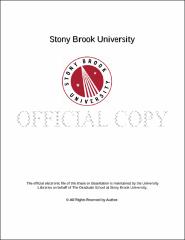| dc.identifier.uri | http://hdl.handle.net/11401/76723 | |
| dc.description.sponsorship | This work is sponsored by the Stony Brook University Graduate School in compliance with the requirements for completion of degree. | en_US |
| dc.format | Monograph | |
| dc.format.medium | Electronic Resource | en_US |
| dc.language.iso | en_US | |
| dc.publisher | The Graduate School, Stony Brook University: Stony Brook, NY. | |
| dc.type | Dissertation | |
| dcterms.abstract | Presented is a measurement of the WW+WZ production cross section in proton-proton collisions at sqrt(s) = 7 TeV using data produced by the Large Hadron Collider and recorded with the ATLAS detector in 2011. The measurement tests understanding of the electroweak sector of the Standard Model at high energies and is potentially sensitive to new physics models that go beyond the Standard Model. The production cross section is measured in the WW/WZ semi-leptonic decay channel where one W boson decays into a lepton (either an electron or muon) and a neutrino, and the other W or Z boson decays hadronically into two quarks. The semi-leptonic final state is challenging due to a substantial background contribution coming from W boson production in association with jets. The measurement is therefore performed in a fiducial phase space that enhances the signal-to-background ratio and provides an adequate separation between the shape templates of the backgrounds including their systematics and of those expected by the WW/WZ signal. The signal contribution is extracted from the data within this fiducial phase space by fitting the electron and muon channel contributions simultaneously using a maximum-likelihood fit to the invariant mass distributions of the two jets that form the hadronically decaying W or Z candidate. The dataset used corresponds to an integrated luminosity of 4.7 ± 0.2 fb<super>-1</super>. The total WW+WZ cross section is measured to be 68 ± 7 (statistical) ± 18 (systematic) pb with a Gaussian significance of 3.5 standard deviations, consistent with the Standard Model prediction of 61.1 ± 2.5 pb. In addition, limits are set on anomalous contributions to triple gauge couplings using the transverse momentum distribution of the dijet system from the hadronically decaying W or Z candidate. | |
| dcterms.available | 2017-09-20T16:51:04Z | |
| dcterms.contributor | Sterman, George | en_US |
| dcterms.contributor | Tsybychev, Dmitri | en_US |
| dcterms.contributor | Zingale, Michael | en_US |
| dcterms.contributor | Pleier, Marc-Andre. | en_US |
| dcterms.creator | Puldon, David | |
| dcterms.dateAccepted | 2017-09-20T16:51:04Z | |
| dcterms.dateSubmitted | 2017-09-20T16:51:04Z | |
| dcterms.description | Department of Physics. | en_US |
| dcterms.extent | 242 pg. | en_US |
| dcterms.format | Application/PDF | en_US |
| dcterms.format | Monograph | |
| dcterms.identifier | http://hdl.handle.net/11401/76723 | |
| dcterms.issued | 2014-12-01 | |
| dcterms.language | en_US | |
| dcterms.provenance | Made available in DSpace on 2017-09-20T16:51:04Z (GMT). No. of bitstreams: 1
Puldon_grad.sunysb_0771E_12036.pdf: 19545444 bytes, checksum: 509f19d0574e6cb2c825d5458263241a (MD5)
Previous issue date: 1 | en |
| dcterms.publisher | The Graduate School, Stony Brook University: Stony Brook, NY. | |
| dcterms.subject | anomalous couplings, ATLAS, cross section, semi-leptonic, WW, WZ | |
| dcterms.subject | Physics | |
| dcterms.title | Measurement of the WW and WZ production cross section in the semi-leptonic final state using sqrt(s)=7 TeV pp collisions with the ATLAS detector | |
| dcterms.type | Dissertation | |

